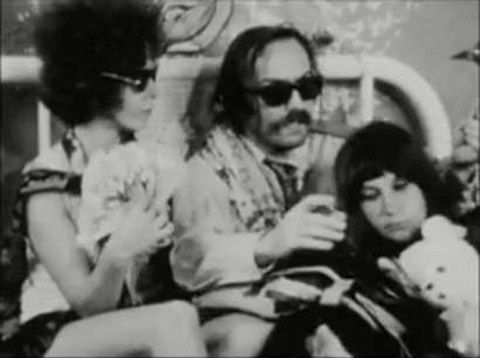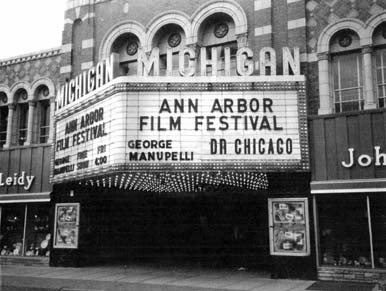Snicker and Yawn, Doctor Chicago
9 Sep 2009

George Manupelli was there at the 47th annual convening of the Ann Arbor Film Festival that he founded. He was present for the Thursday evening screening his 1971 16-millimeter feature “Cry, Doctor Chicago”. Manupelli also spoke earlier that afternoon as part of the University of Michigan College of Art and Design Penny Stamps Lecture Series. Costume and performance artist Pat Oleszko, in residence in the College for part of the winter semester, gave a warm and appreciative introduction to Manupelli’s lecture. She recalled warmly how he would arm wrestle students for a grade, credited him for causing “genetic damage” to his students (including herself), and quoted him as saying “Anything worth doing well isn’t worth doing at all.” This last statement, his declaration to his right of laziness, seems to have been an operating principle behind his shambling Doctor Chicago trilogy, of which “Cry” is the penultimate.
Onstage, the octogenarian muttered an ongoing droll patter, one gag after another, clearly an old vaudevillian. In an unwitting homage to the university’s Richard Hackel, he showed what he claimed was a self-portrait, opthamological photographs of the blood vessels of his eyes. Stills from one of his early black and white films featured the ubiquitous young nude women of 1960s underground cinema. Manupelli mentioned allusions to Emmanuel Velikofsky’s Worlds in Collision appearing in the second Doctor Chicago film. Evidently the stuttering of the lead actor who played the Doctor is a running joke in the trilogy too.
Manupelli has many stories to tell of the Festival’s inception and first two decades. He credited the Once Festival in Ann Arbor in 1961 and musical Once Group that sprang from it for inspiration to start the Film Festival. He boasted how he was the second to use an electronic music soundtrack in a film (following only a Japanese monster movie). He sent Andy Warhol $350 to rent a van and bring the Velvet Underground and Nico to the Festival, and it took them three days to arrive, “driving mostly on sidewalks.” One film shown at the 1965 Festival, “Jerori,” included a man dancing in a loincloth. At the end of the film the man had an ecstatic expression on his face; this resulted in the Festival being busted as "pornography." When asked by the UM College Dean if the actor was masturbating, Manupelli replied he didn’t know, because he himself had never masturbated or seen anyone masturbate and asked the Dean what it would look like, perhaps including the facial expression. That film, as well as a Festival poster Manupelli designed featuring two embracing women (one in a bustier), resulted in a campaign by the John Birch Society against the Festival.
Seeing his slides of the photography-repurposing Festival posters and tickets he created, I realized that George Manupelli was one of the first image-appropriating artists that impressed me as a teenager in Ann Arbor (another was cartoonist The Mad Peck in CREEM magazine). While I had seen Roy Lichtenstein’s comic-derived paintings, Manupelli and Peck assembled multiple source images instead, in juxtaposition, for a greater density and intellectual provocation. Manupelli’s ephemera had a handmade quality that was both urbanely hip and easy for a kid to copy. He made seventeen visits to Nicaragua during the post-Somoza Sandinista regime and US-supported Contra terrorists against them, and in Nicaragua, he grabbed a 1930s photo of revolutionary Augusto Sandino, enlarging it so the dots in its screening process were very obvious, to create a print he gave to his various hosts in that nation as a gift.
As his University of Michigan Art Department gave Prof. Manupelli negligible support for teaching or making cinema, he now reminds students “Not only do universities not think outside the box, they are the box.” At the showing of “Cry, Doctor Chicago,” Chrisstina Hamilton (Penny Stamps Lectures administrator, and briefly Ann Arbor Festival Director a few years ago) urged everyone to buy Manupelli’s DVD of the Doctor Chicago series, hyperbolically declaring that it “should be in every library in America.” Well, no, but it certainly should be in University of Michigan’s, and--for reasons I’ll explain below--the local high schools. Doctor Chicago (and Chicago-like) movies were a part of my own adolescence, so I note their intersection with it, and my art gang, at numerous points.

In “Cry, Doctor Chicago,” a French schemer swears revenge against the Doctor. In Mexico where the Doctor and his companion Sheila are staying, the Gallic avenger allows himself to be cheated out of a villa in a rigged card game. Once back in the United States, the duo is met at the railroad station; a Penn Central train rolls up to the Gandy Dancer and an Allen Ginsbergly-bearded chauffeur greets them. The car stops in the countryside to allow Sheila to pee, discreetly shielded by the chauffeur’s sport coat. The summery country road and field resemble the one where high school student filmmakers Steve Dunning and Jimm Juback shot their 8-mm “Tim of Athens” that same year, and one expects its actor Alan Good to walk up, dressed for tennis and carrying a rifle. Or, for Nico and Iggy Pop to cavort among the crops, as in Francois de Menil’s 1969 “Evening of Light,” also filmed in Michigan’s Washtenaw County.
The character Doctor Chicago is a small-time hustler, a doctor envisioning a constellation of “medicine and money.” Hearing this line today, one is reminded that this was the era when a physician named Frist (father of the Republican Senator) was establishing the first health maintenance organization, the dreaded HMOs that so restricted health care in this nation; HMOs were critically analyzed in an issue of Scientific American magazine about that time. We see Chicago practice no medicine in the movie, though when introduced to the villa’s wheelchair-bound cook (actually the vengeful Frenchman), Chicago promises to get him “up and walking in no time.” Though we hear no bluesy music, in a soliloquy on the blues the Doctor tells of “the catfish... some learned to walk,” a motif the song-writing Bison Boys (Jimm Juback, Gary Malvin, Mike Mosher) also used that year, following reports by Malvin of the creature he learned of during a Florida vacation with his parents. “Cry, Doctor Chicago” also includes a fat, snorting old bulldog, a strip poker game, and a pleasant forty or so minutes of droll caper stretched into 111 minutes. If the power goes out in a freezer, you might have to consume gallons of ice cream before it melts; did Manupelli have a surfeit of fugitive film stock that had to be used up...?
Now, I have a thesis about early-1970s Michigan: the turmoil of racial integration, especially after the 1967 Detroit riots, pressed upon all the arts and culture in the region, whether visibly and explicitly or subconsciously. Consequently, there followed decadence, in exhaustion of the previously inspiring struggle for civil rights and justice. The cheerful and pretty love songs of Motown disappeared, and even Marvin Gaye and Stevie Wonder had grown serious and sociopolitical (and, soon after, the inspiring Motown corporation left Michigan). In white youths’ Detroit rock, the revolutionary, Kick Out the Jams carnival collectivism of the MC5 gave way to the sullen Gimme Danger anomie of the Stooges.
If one jumps a third of a century later, our fellow Michgan teens-of-that-era show the impact on their work in mid-life: Ken Burns never stops talking about race in America, while Mike Kelley revisits high school tropes to talk about everything disturbing except race. “Cry, Doctor Chicago” can be sited in terms of 1971 race relations and malaise. As can its galumphing humor.
During his afternoon Penny Stamps talk, George Manupelli showed a portion of the second film “Ride, Doctor Chicago.” Upon realizing that an unconscious woman found in the desert is a Native American, Chicago sneers “I thought she was a Spic or a Dago” in gratuitous ethnic abuse. Towards the conclusion of “Cry, Doctor Chicago” Steve, the retarded-qua-barbaric nature boy, seemingly couples with June, then becomes close to Lincoln (played by Lincoln Scott), a spear-carrying African clad in white fur or marabou feathers around his waist. Chicago jokes about giving Lincoln a job as the cook on the Cream of Wheat box, and we next see him in the kitchen in cook’s hat with a Cream of Wheat box, alongside the villa’s two female Chinese cooks; the cheap turd of a joke floats embarrassingly in the punchbowl script. The movie ends with Steve himself a floater, face down “Sunset Boulevard”-style in the villa’s pond, with Lincoln’s spear protruding from his back. Was this Manupelli’s manifestation of fear of angry Detroit? Fear of his black students? Was Lincoln Scott doing this acting stint for a grade? What did Scott think of the finished movie? What did his black friends think? The viewer recalls how “spearchuckers” was one of the derogatory terms for blacks heard in the halls of Ann Arbor high schools at the time.
Cranbrook House, the Booth family’s 1920s luxury in verdant and bucolic Detroit suburb Bloomfield Hills, stands in for the French conniver’s villa. Perhaps Detroit blacks, all off-screen except for the exoticized Lincoln, are like barbarians invading a bourgeois dinner party in a 1970s Luis Buñuel movie. When Doctor Chicago recites Poe’s “The Raven” (one searches for reasons, or symbolism: ravens emblematic of black people?), we are aware that he doesn’t stutter. Yet the poem’s insertion feels gratuitous, pompous, a shadowy stretch of fake melancholy and morbidity in the midst of a colorfully floral midwestern summer.
In Ann Arbor artists younger than Manupelli, class-clown humor proved a healthy response to this sociopolitical Michigan malaise. This manifested in the self-referential satire in comics written and drawn by Link Yaco, Paul Remley and myself, as well as the Bison Boys’ songwriting mix of cornball Americana, dandyish Bonzo Dog Band whimsy, and self-consciously arty Dada (inspired by Hans Richter’s Dada: Art and Anti-Art and Marcel Duchamp’s “Box in a Valise” at the UM Museum of Art). And while many of us reveled in tenebrous hashish, Procol Harum and Aubrey Beardsley, it’s difficult to really feel jaded as a teenager, when so much lies ahead to be explored. There’s little reason for privileged university-brat sixteen-year-olds to embrace the idea that their society’s best times are behind them.
Manupelli’s humor is steeped in dopey 1970s aimlessness, with flashes of classic comedy. When Chicago and Sheila discover that Steve has shot the Frenchman’s lady, they adopt the “Yaaah, let’s get outa here!” working-class survival strategy characteristic of the Three Stooges (who, as Dr. Howard, Dr. Fine, Dr. Howard in the 1934 short “Men in Black,” roll out of their hospital on scooters). In the garden, behind Steve’s body, June follows Chicago and Sheila as they skedaddle away, imploring “Cry! Cry, Doctor Chicago!” And credits roll.
Spirits are lifted mid-movie when Pat Oleszko does a quick boomba-boomba strip tease under red light. She wears a Venetian carnival bird mask that’s a cousin to the over-the-head crow masks purloined that year from a local theater company to reappear in Steve Dunning’s film “The Svalbird.” One recalls the Manupelli-made film of Oleszko nude in the cab of a semi-truck, playing behind Commander Cody and his Lost Planet Airmen at Hill Auditorium April 1971, until local teenage feminists—Human Rights Party activist Sonia Yaco among them—leapt onstage and stopped the concert. In a subsequent upbeat scene in “Cry, Doctor Chicago,” Chicago and Sheila appear onstage at Gallup Park during a Sunday rock concert, and the audience gamely plays along. Perhaps my crowd and I were there, ignoring the actors as we did any political announcements from the stage. If Mike Higgins (1954-74) could take the stage to launch a bucket drive to collect funds for the nonexistent radical prisoner “Father Chinner,” as he did in 1973, one could easily film a movie scene there.

Around 1970, as the Hollywood film industry sought to tap the burgeoning youth market, there were free-form movies, like Dennis Hopper’s “The Last Movie” or Neil Young’s “Rust Never Sleeps.” Encouraged by the success of Woody Allen, there was self-reflective, neurotic humor. Like Ulu Grosbard’s “Who Is Harry Kellerman (and Why Is He Saying Those Terrible Things About Me?).” In that movie, a psychiatrist becomes a tollkeeper, ski-instructor, bursts into a dismissive Ray Charles song, much as a character would in an early Mad magazine satire by Harvey Kurtzman and Will Elder. There are longuers in Grosbard’s movie, seeming deep. Yet there’s no snap, and the viewer feels little engagement with the characters, least of all the hero.
Smart teenagers, growing aware of the absurdities of adult life and its demands, are hungry for humor. George Manupelli deserves Michigan’s thanks for providing some, in a too-often grim and politicized (Vietnam War! The Motor City is Burning!) era that represented itself with great revolutionary seriousness. In a world of scattershot imagery and nonlinear cinema, Juback appreciated the narrative that carried the Dr. Chicago movies along, despite the dallying pace. Asked recently about Manupelli, Juback recalled that he thought the Dr. Chicago series “hysterical” when he saw them in high school, and reflected:
"I concede that for me there is a generational/historical component at play ... I sort off looked up to these films as the work of an older brother who claimed a more legitimate claim to the role of beatnik, based on what he lived through ... but what seems to frustrate my generation or younger people [is to] see a lot of Manupelli era artists as drunks, slackers, ne’er do wells, etc. Everybody seems to roll their eyeballs at this guy. Times have changed."
One looks for visual artistry in films made by artists and art students. Except for cantina murals in “Cry, Doctor Chicago,” painted by John Copley and Betty Schreiber, the Cranbrook manor house sets--like the western hillside in “Ride, Doctor Chicago”—are largely as Manupelli found them. His unimaginatively quotidian filmic environments serve his mise-en-scene, populated by actors in street clothes. In “Daniel Boone,” Jimm Juback was influenced in by pictures of the costumed panto mummery-foolery of the Bonzo Dog Doodah Band’s television folly, “The Donut in Granny’s Greenhouse,” which reached the United States in the booklet that appeared with on the band’s Urban Spaceman album. At one point during “Daniel Boone” filming, surrounded by his friends all dressed up as red Indians (and the late Neil Baumler as Pa-Pa Bear), Juback exclaimed delightedly with arms outstretched, “This is like a Bonzo Dog movie!”
Meanwhile, Juback’s contemporary Cary Loren grew up about thirty miles nearer Detroit, but adopted and displayed in his movies a Warholian Big Apple aesthetic different in mood and manner from the elitist European Dada moments that Juback’s Bison Boys occasionally sported. Loren made Super 8 films evincing a Jack Smith-influenced use of glittery costumes, bare flesh and boys in makeup. Ingrid Good, who appeared as a teenager in several Loren movies and photo shoots, remembers George Manupelli bursting into the dressing room at Ehnis Brothers clothing store in downtown Ann Arbor to film her, all the while “rambling on about what a great cameraman he was.” Yet compare Manupelli to another boy George, George Kuchar of San Francisco, another 1970s filmmaker who worked with a broad brush of humor, and like Jack Smith, reveled in a brazenly camp aesthetic. While Manupelli generally uses found ambient or quotidian lighting (save Oleszko’s dance), or the hazy sunlight of a Michigan summer, Kuchar illuminates actors with fakey reds, blues, even a raking hot white light that visually cues up the Velvet Underground’s “White Light, White Heat” when it’s employed. Manupelli uses music less dramatically than Kuchar. What the viewer misses in Dr. Chicago yarns is the overwrought fizz and sizzle found in Kuchar productions like “Sins of the Fleshapoids.” In this decade, Guy Maddin skillfully continues this tradition, with the silly short “Sissy Boy Slap Party” and his evocatively retro 2004 feature “The Saddest Music in the World.”
Perhaps I was always picky or arbitrary about stoner cinema; I walked out of Frank Zappa’s 200 Motels in November 1971 convinced it was the worst movie I’d ever seen (viewed with Jane Hammitt, whose brother Harry appeared on a record with a Bonzo Dog veteran he’d sought out in England). Yet both Juback and Loren, the latter’s swirly visual woo-woo set to Destroy All Monsters’ noise, made more concisely interesting films than Zappa, or than Manupelli’s languid “Cry, Doctor Chicago.”
Blinking awake, it’s 2009. The day after I saw “Cry, Doctor Chicago,” in a rambling lecture on several filmmakers active during the early days of the Ann Arbor Film Festival, Gerry Fialka quoted Harry Smith’s assertion that the most flattering reaction to a film was to fall asleep during it. At the 47th Ann Arbor Film Festival, the epicurean Arbor Coffee and Tea Roasters had samovars of their wares in the lobby, and I accidentally grabbed a relaxing tea rather than coffee on my way in to “Cry, Doctor Chicago,” but finished it. To find myself nodding out in the middle of the movie made me miss the attention/inattention span-fortifying reefer of adolescence, puffed to leaven a teen’s Haw! Score! sense of humor, that back in the day, so helped a viewer of Doctor Chicago’s humbug practice pass the time.
◊